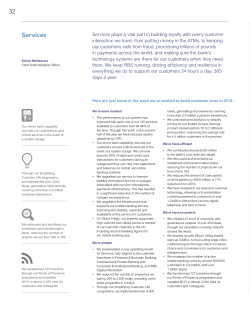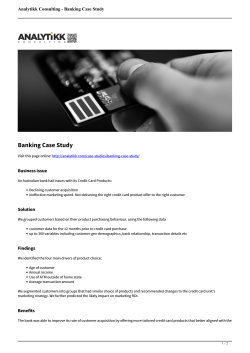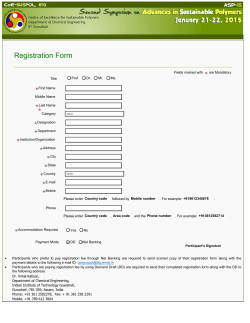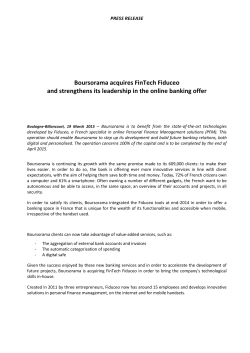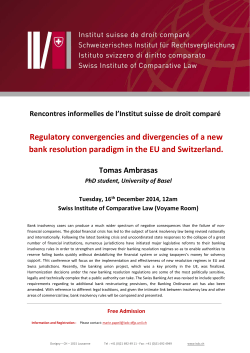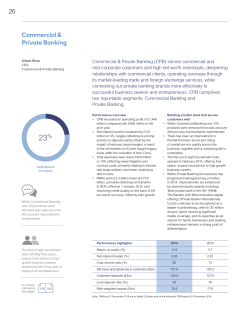
Perceived e-Service Quality: Study in the consumer
Journal of Contemporary Management Sciences Volume 4 (2) 79-88 JCMS Publication, 2015 Journal of Contemporary Management Sciences Perceived e-Service Quality: Study in the consumer-banking sector Yohan Wismantoro Ririh Dian Pratiwi Wikan Isthika Faculty of Economics and Business, Dian Nuswantoro University, Semarang - Indonesia yohan309@gmail.com ABSTRACT The development of information and communication technology influences the structure of behavior in the various sectors of the economy, both micro and macro. This paper explores the impact of e-service dimensions on perceived e-service quality in the consumer-banking sector. In the banking industry, information and communication technology enables the development of customer service where customers can actively participate in transactions with a technology called self-service technology (SST). In order for the application to provide optimum benefit to the bank, the quality of SST becomes very important because it is directly related to satisfaction and customer loyalty. By using regression analysis approach, this study aims to determine the effect of e-service dimensions which consists responsiveness, easy to use, personalization, security, and web design on perceived e-services quality. The results indicate that only the dimensions of responsiveness and security are statistically proven positive and have significant effect on the perceived e-services. It reflects the importance of responsiveness and security for a customer. Therefore, the design system of e-services are increasingly responsive (fast response) and provide security is very important to be developed by the service provider. Keyword: e-service dimensions, self-service technology (SST), perceived e-service quality 1. INTRODUCTION Nowadays, service providers offer their customers information technology (IT)-based service to be more competitive in their business. They use to reduce production and service cost as well as to create value-added services. IT-based services such as Internet services, self-service machines and touch-phone services are rapidly increases. Thus, customers become more familiar with self-service technologies (SSTs). The occurrence of SSTs has stimulated predictions of how technology will affect interactions between customers and service providers. Dabholkar et.al. (2003) states that IT can help enhance service quality by increasing convenience, providing extra services, and collecting service performance information for management use. Fitzsimmons and Fitzsimmons (1997) highlight the advantages of IT in services such as the creation of entry barriers, enhancement of productivity, and increase of revenue generation from new services. Many service industries have used IT-based service systems to remain competitive (Shu-Hsun Ho and Ying-Yin Ko, 2008). In Indonesia, these phenomena are triggered by significant diversification of digital money, which has occurred since 2012. Nowadays, the use of digital money is significantly increasing, although it is still lower than that of common money and demand deposit. It has increased from 586.046 transactions to 137 million transactions. Debora (2014) in startupbisnis.com states that internet banking transactions in Indonesia reach Rp.3.642 billion. The increasing number of internet banking users is closely related to the facilities and internet access, which have been widely spread throughout Indonesia. The rapid development of internet access causes the banks to gradually increase their services by maintaining their websites and providing various services such as SMS banking and internet banking. Several researches have been conducted to measure the quality of online services in banking industries as well as other industries. Gauli and Kumar Roy (2011) had conducted a research which shows that common services quality influences costumer's satisfaction and loyalty. Another research done by Singh (2013) finds that technology development has changed the banks. Banking industries always improve their service quality because they realize that it is highly related to customers‟ satisfaction. The role of IT-based service in increasing customers‟ satisfaction has been shown in several previous researches that are expected to bring the perception of customers about the overall quality of services (Zhu et.al, 2002; Yen and Gwinner, 2003; Wang et.al, 2003; Janda et.al, 2002). This research focuses on the impact of electronic services given by banking industries (which include ATM service, EDC service, mobile banking and e-banking services) on the customers‟ perceived e-service quality. The hypothesized model is then tested based on the data collected from a sample of bank customers. The data were analized by using regression analysis approach. 2. LITERATURE REVIEWS IT-based service and E-Banking Quality Nowadays, information technology has changed the shape of the services in many ways. Therefore, it is necessary to incorporate attributes of IT-based service delivery system as part of a service quality measurement (Zhu et.al, 2002). In an environment where goods and services are available in the form of digital information, customers can serve themselves without having a face-to-face encounter (Internet Self Service Technology). It is very crucial to maintain the continuous use of Self-Service Technology in order to obtain the customer perceptions. This study refers to the concept of IT-based services suggested by previous studies, such as the Yen and Gwinner (2003), lose a few attributes of Internet Self Service Technology (ISST) i.e. control, on performance, convenience, and efficiency. Wang et.al (2003), Technology Acceptance Model (TAM) found that computer self-efficacy had a significant effect on some of the things that are attached to internet technology, namely perceived usefulness, ease of use and credibility. Janda et.al (2002) found the variables of performance, access, security, sensation, and information. The study results of Walker et.al (2002) include the capacity, desire for control, individual needs fulfillment, perceived accessibility and complexity, perceived risk, perceived relative advantage, and technical reliability. Furthermore, Moutinho and Smith (2000) in "Modelling bank customer satisfaction through mediation of attitude towards human and automated banking" generate ease of banking factor variable. Jun and Cai (2001) in his research lowering the 6 (six) dimensions of the online system, i.e. the content, accuracy, ease of use, timeless, aesthetics, and security. Radomir and Voicu Nistor (2012) state that electronic banking services enable the banks to deliver their products and services directly to their customers. Online service is not limited to transactions via website. It refers to the facilities that do not require face-to-face interaction between the customers and bank officials. Transactions through ATM, internet banking, and mobile banking are some examples of e-service. In other words, e-service occurs when the customers do the transactions through interface, ATM, and website to fulfill their needs. E-service is expected to be an effective and efficient banking facility. A research conducted by Hermana (2010) shows that e-banking users in Indonesia mostly have an undergraduate degree and an established career with medium to high income. The result also demonstrates that there is no different perception about e-banking service from private or state-owned bank. This is because the government does not distinguish monetary authorities in terms of banking regulation and monitor. An interesting finding reveals that customers using e-banking perceive that e-banking is relatively unsafe. The research suggests that in the future, the quality of information and transaction security becomes an influencing factor in the e-banking service competition in Indonesia. Besides, the research introduces the advance of technology, especially internet and e-banking for middle to low class society. Thus, through e-banking all bank services can be benefitted by all customers. 3. Hypothesized Model This research adopted Al-Tarawneh and Atallah (2012): Measuring E-Service Quality from the Customers' Perspective: An Empirical Study on Banking Services. They proposed the key dimensions of e-service quality are reliability, responsiveness, easy to use, personalization, security, and website design (See table 1 for the constructs definitions). This research found that E-service quality was directly associated with customer perceived service quality. Table 1. Constructs definitions Construct Definitions Customer perception of reliability of the site (e.g., confirmation emails, order Reliability tracking functions) and accuracy of service promises(e.g., delivering what is ordered) Responsiveness Easy to Use Personalization Customer perception about the fast response givenand getting the help when needed. Customer perception of the user-friendly e-service system Customer perception of the individualized attention and differentiated service that are tailored to the individual needs and preferences Security Customer perception of the accuracy and security of financial transactions Web Design Customer perception of the website interface such as visually appealing and IRC-2015 THAILAND Page 3 well designed website This study uses the SERVQUAL model as its starting point suggests that: H1 : E-service quality dimensions (reliability, responsiveness, easy to use, personalization, security and website design) are correlated to overall service quality. H2 : There are positive relationships between dimensions of e-service quality and perceived E-service quality Reliability Responsiveness Easy to Use Personalization Perceived E-Service Quality Security Web Design Figure 1: Proposed Model Statistically all indicators have been tested and have met validity and reliability criteria (Ghozali, 2005). Partial least square was conducted to analyze the relationship between variables related to the perception about eservice quality. After testing the classic assumption, correlation analysis was conducted. This proves that the data were free from multi co linearity. Studenmand (1992) states that the relation between variables should not be higher than 0.80. The result shows that the relationship between variables is under 0.90 with the highest score 0.702. This highest score is between „easy to use‟ and „personalization‟ variable. 4. DATA COLLECTION AND ANALYSIS The population of this research is bank customers who used e-service facilities in Semarang, Indonesia. By using non-probability sampling approach, this research used a set of data from 100 academician respondents who are expected to have enough knowledge about IT. E-service form several banks (Bank Mandiri, BRI, BCA, BNI, Bank Danamon, Bank CIMB Niaga, BII, Bank Jateng, BII dan Bank Muamalat) are represented in this research. Demographically, the respondents consist of 43 males and 57 females. Most of them (61 percent) are married. Based on their age, they were grouped into three categories: 47 percent are 25 – 30 years old, 22 percent are 31 – 36 years old, and 31 percent are older than 36 years old. The data shows that most of the respondents have been using eservice facility for more than two years. Partial least squares test was used to measure the relationship between variables that related to the quality of service and the customers‟ perception. Independent variable influences the dependent variable when the significance value is under 0.05 (Ghozali, 2005). Meanwhile, Partial Least Squares test was also used to see the relationships between variables in e-service quality aspect (such as reliability, responsiveness, easy to use, personalization, security, and design) and customers‟ perception on e-service quality. 5. RESULTS AND DISCUSSION Table 2 shows that e-service quality variables (reliability, responsiveness, easy to use, personalization, security, and website design) correlated to overall service quality as we proposed in H 1. Tabel 2. Correlation Analysis Easy to Personali- Variabel ESQ Reliability Responsiveness Use zation Security Design ESQ 1 0.486 0.495 0.526 0.55 0.581 0.523 1 0.414 0.597 0.535 0.397 0.450 1 0.221 0.324 0.332 0.272 1 0.702 0.557 0.684 1 0.504 0.581 1 0.584 Reliability Responsiveness Easy to Use Personalization Security Design 1 Tabel 3. ANOVA Test Result Model 1 Sum of Squares Df Mean Square F Sig. Regression 133.742 6 22.290 16.711 .000a Residual 124.048 93 1.334 Total 257.790 99 IRC-2015 THAILAND Page 5 Tabel 4. Regression Test Result Unstandardized Standardized Coefficients Coefficients Collinearity Statistics Model B Std. Error Beta T Sig. Tolerance VIF 1 (Constant) -1.033 .950 -1.087 .280 Reliability .056 .065 .084 .865 .389 .551 1.815 Responsiveness .152 .046 .271 3.287 .001 .759 1.317 Easy .038 .060 .078 .628 .531 .332 3.013 Personalization .102 .066 .166 1.559 .122 .454 2.202 Security .155 .054 .270 2.855 .005 .578 1.729 Design .066 .067 .103 .975 .332 .461 2.170 Table 3 shows the test result of the model used in this research. The test shows the significance value is p=0.000. This means that the model of this research can be used because the significance value is under 0.05. Furthermore, it is also found that R2 value is 0.519 or 51.9%. It means that the independent variables in e-service quality (independent variables) influence the costumers‟ perception about e-service quality (dependent variables) for 51.9% while the rest of the dependent variables are influenced by other variables that are not included in this research. The result of partial least squares test is shown in table 4. It discloses that all the variables of e-service quality, i.e. reliability, responsiveness, easy to use, personalization, security, and design, are positively correlated to costumers‟ perception on banking e-service quality. However, there are only two variables that significantly influence the customers‟ perception. Those variables are responsiveness and security with significant values p=0.001 and p=0.005 respectively. Meanwhile, the statistic test shows that reliability, ease of use, personalization do not significantly influence customers‟ perception (significance value p>0.05). This result slightly different with the previous research conducted by Tarawneh and Atallah (2012) in Amman, Jordan. They found that all variables such as reliability, responsiveness, ease of use, personalization, security, and design influenced the customers‟ perception about e-banking services. In this research, only responsiveness and security are proven to be significantly influence the perceived service quality. In addition, reliability has the strongest influence than any other variables. Sakhaei, Afshari, and Esmaili (2014) used seven variables that influence service quality of internet banking users in Iran. They found that reliability is the most effective variable that influenced the customers‟ perspective on service quality. The result of this research is in line with Khalil‟s (2011) research that analyzed online service quality and customers‟ perception in Bank Islam Malaysia Berhad. Khalil (2011) used four variable dimensions, i.e. tangibility, reliability, responsiveness, and empathy. He found that both reliability and responsiveness influence customers‟ satisfaction, but responsiveness is the strongest influential variable. In addition, Zafar, et.al (2011) states that customers‟ satisfaction can be measure through quality aspects such as efficiency, reliability, responsiveness, fulfillment, privacy, and assurance. The different results may due to the different region of the population and sample used. However, the result of this research is in line with Khalil‟s (2011) that used Malaysian as the research subject and found that responsiveness variable has the strongest influence on customers‟ satisfaction. Furthermore, this research is also indirectly in line with Tarawneh and Atallah, K (2012) in which security is confirmed as the strongest variable. Although it is slightly different with previous model proposed by Al-Tarawneh and Atallah (2012) in which all variables (reliability, responsiveness, ease of use, personalization, security, and web design) influenced the customers‟ perception on e-banking services, the result can be explain as follows: Responsiveness relates to the fastness, preciseness, and clarity of the responses given by the bank to help or serve the customers. In this study, the hypothesis that assumes responsiveness significantly influences perceived e-service is statistically proven. This indicates that the ability and willingness to give fast and precise service to the customers by giving clear information are very important for the customers. Thus, the effective and fast service and the clarity of information given by the bank are the key factors of e-service quality. When the customers face some problems related to the bank service, they will get fast and precise information to solve their problem. For example, when the customers accidentally input the wrong transaction code, they will only need to send their data through e-mail for the customer service without having to go to the bank directly. This result relates to one of the advantages given by IT-based service, i.e. eliminating the distance and time of service problems. By using IT-based service, customers do not have to queue in front of the service counter. It also gives flexibility and fast responses form the bank as expected by the customers. Security is also statistically proven to be the significant variable that influence the perceived service quality. The ability to ensure the customers‟ data security and electronic transactions is one of the most important aspects. Most of the customers concern about their private data such as PIN, ATM chip and e-banking password as an unauthorized access of these private data may cause the customers to lose their money in their account. Therefore, security is one of the most important aspects considered by the customers. Meanwhile, other variables such as reliability, ease of use, personalization, and web design are not significantly determining. Although they give better comfort in using e-service, they do not directly relate to customers‟ financial condition, especially the disadvantages that may occur from e-service transactions. 6. CONCLUSSION E-service given by the bank affects the customers‟ perception which in turn will influence the costumers‟ satisfaction thus maintaining their loyalty to the bank. The consumers‟ perception can be obtained from advertisements, past experiences, to people‟s opinion. To measure the consumers‟ perception of e-service quality, the following dimensions were used: reliability, responsiveness, easy to use, personalization, security, and web design. IRC-2015 THAILAND Page 7 Through partial less squares testing, it is found that reliability, responsiveness, easy to use, personalization, security, and website design as e-service quality dimensions are significantly and positively correlated. It demonstrates that a better perception of one dimension encourages a good perception of other dimensions. Several dimensions that have the strongest relationship are easy to use and web design, and reliability and easy to use. Furthermore, the testing on the influence of e-service dimensions to perceived e-service quality shows that only responsiveness and security have a significant influence to perceived e-service quality. Both dimensions are directly related with the financial flow of the customers‟ accounts. Based on these findings, it is important that e-service providers (banks) inform and socialize e-service attributes, especially those relating with e-service transaction security tips. Banks are also expected to develop an e-service system that provides fast and accurate services to enhance perceived service quality. It is hoped that the next research can make sample specifications, for example, comparing certain banks in Indonesia so we will know the quality of those banks from the customers‟ perspective. The samples need to be expanded, not only academicians but also private sector workers who have middle to low income. The research can also be developed to test the relationship of customers‟ satisfaction and loyalty. BIBLIOGRAPHY 1. Ahmed, K. (2011), Online Service Quality and Customer Satisfaction: A Case Study of Bank Islam Malaysia Berhad, MPRA Paper NO. 30782. 2. Al-Tarawneh dan Atallah, K. (2012), Measuring E-service Quality From The Customers‟ Perspective: An Empirical Study on Banking Services, International Research Journal of Finance & Economics, issue 91 hal. 123. 3. Debora, T. (2014), Pertumbuhan Internet Banking dan e-Commerce di Indonesia: ATM dan CoD Mendominasi, posted 17 March, Retrieved from http://startupbisnis.com pada 02 September 2014. 4. Croom, Simon and Johnson, Robert. 2003. E-service : enhancing internal customer service through eprocurement, International Journal of Service Industry Management, Vol. 14(5) 5. Dabholkar, P.A., Bobbitt, L.M. and Lee, E-J. (2003), “Understanding consumer motivation and behaviour related to self-scanning in retailing: implications for strategy and research on technology-based selfservice”, International Journal of Service Industry Management, Vol. 14 No. 1, pp. 59-95. 6. Fitzsimmons, J.A. and Fitzsimmons, M.J. (1997), Service Management: Operations Strategy, and Information Technology ,2nd ed., Irwinand McGraw-Hill, NewYork, NY 7. Ganguli, S dan Kumar Roy, S. (2011), Generic Technology-Based Service Quality Dimensions In Banking: Impact On Customer Satisfaction And Loyalty, Inte rnational Journal of Bank Marketing, Vol. 29 No. 2 hal. 168-189. 8. Hermana, Budi. (2010), Pengukuran kualitas layanan internet banking, Jurnal Ekonomi Bisnis No.1, Vol. 15 hal.47-57. 9. Janda, S., Trocchia, P.J., and Gwinner, K.P. 2002. Consumer perception of Internet retail service quality. International Journal of Service Industry Management, vol 13 10. Jun, Minjoon and Cai, Shaohan. 2001. The key determinants of Internet banking service quality: a content. International Journal of Bank Marketing 19/7 11. Jawa Pos. (2014), Penggunaan e-Banking Naik Pesat: Menggeser Transaksi Konvensional, Retrieved www.jawapos.com 23 Mei 2014 pada 02 September 2014. 12. Kontan.(2014), Ini 4 Perkembangan Penting Industri Perbankan, Retrieved http://keuangan.kontan.co.id 19 Januari 2014 pada 02 September 2014. IRC-2015 THAILAND Page 9 13. Monalisa, S dan Suryani, E. (2013), Pengaruh Kualitas Layanan Internet Banking Terhadap Kepuasan Dan Loyalitas Nasabah Bank Dengan Menggunakan Sistem Dinamik, Prosiding Seminar Nasional Manajemen Tekhnologi XVII, hal. 1-8. 14. Ghozali, I. (2005), Aplikasi Analisis Multivariate Dengan Program SPSS, Edisi Ketiga.Semarang: Badan Penerbit Universitas Diponegoro. 15. Gujarati, D., N., and Porter, D., C. (2009), Basic Econometric (5th ed.). New York: McGraw-Hill. 16. Parasuraman. A, Zeithaml, Valerie A and Berry, Leonard L. 1988. SERVQUAL : A Multiple –Item Scale for Measuring Consumer Perceptions of Servvice quality. Journal of retailing 64/1 17. Radomir, L dan Voicu Nistor, C. (2012), High-Educated Consumer Perceptions Of Service Quality: An Assessment Of The SSTQUAL Scale In The Romanian Banking Industry, Procedia Economics and Finance 3, hal. 858-864. 18. Sakhaei, S.F., Afshari, A.,J., Esmaili, E. (2014), The Impact of Service Quality on Customer Satisfaction in Internet Banking, Journal of Mathematics and Computer Science, hal. 33-40. 19. Shu-Hsun Ho and Ying-Yin Ko. (2008). Effects of self-service technology on customer value and customer readiness. Internet Research, Vol. 18 No.4 20. Singh, Shamsher. (2013), The Impact Of Service Delivery Quality On Costomer Satisfaction In Indian Banks, International Journal Financial Services Management, Vol. 6 No. 1 hal. 60-78. 21. Snellman, Kaisa and Vihtkari, Tiina. 2003. Customer complaining behaviour in technology-based service encounters. International Journal of Service Industry Management, Vol. 14(2). 22. Studenmund, A., H. (1992), Using Econometrics: A Practical Guide (2nd ed.). NewYork: HarperCollins. 23. Wang, Shun-Yi., Wang, Yu-Ming and Lin Hsin-Hui, 2003. Determinants of user aceptance of Internet banking : an empirical study. International Journal of Service Industry Management, Vol. 15 (5) 24. Yen, Hsiu Ju Rebecca and Gwinner, Kevin P. 2003. Internet retail customer loyalty : the mediating role of relational benefits. International Journal of Service Industry Management, Vol.14(5). 25. Zafar, M., Zaheer, A., Saleem-ur-Rahman, dan Kashif-ur-Rehman, (2011), Impact of Online Service Quality on Customer Satisfaction in Banking Sector of Pakistan, Journal of Business Management Vol. 5(30), hal. 11786-11793.
© Copyright 2025

